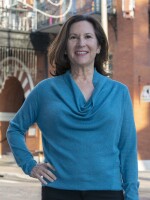Florida Southern College in Lakeland is building a brand new house designed by Frank Lloyd Wright -- even though the architect died in 1959. And college officials say the new structure is part of their plan to become one of the country's premiere cultural destinations.

President Ann Kerr is steward of a campus with the largest collection of Frank Lloyd Wright buildings in the world. It's been dubbed the nation's most beautiful campus by The Princeton Review. It's also a bit of a money pit. The concrete blocks on Wright's buildings at Florida Southern are cracking and crumbling in the Florida heat and humidity. Kerr says it will cost $52 million to restore and preserve them.
Kerr was looking for a way to raise that money, without tapping into tuition dollars at the private college. When plans were recently uncovered for faculty housing that was designed by Frank Lloyd Wright for the campus, but never built, Kerr thought: revenue source.
"I thought about taking one of these unbuilt designs and building it," Kerr says, "and this faculty house was perfect because of its size, because of cost, we had the perfect location, and indeed it will be the first time in about 66 years that an original design is built for the original client on the original site."
Right now, Kerr estimates that about 30,000 people are visiting the campus every year to admire Wright's architecture. She's aiming to more than triple that.
"Frank Lloyd Wright aficionados from around the world love to see his sites," she says. "We've set a goal to become one of the top ten cultural tourist destinations in the United States. And we think that's achievable with what we have to see here."
The small house is under construction across the street from Kerr's office. Kerr says they've hired one of the nation's foremost preservation architects for the job, Jeffrey Baker, principal partner in the firm Mesick Cohen Wilson Baker architects in Albany, New York.

As we walk through the carport with its cantilevered roof, Baker says to imagine how strange this house would have seemed in 1938, when Wright designed it.
"When you look at this house," Baker says, "it's almost as if some alien being came in from the future and came up with these concepts that were so far ahead of his time that people couldn't grasp what Wright was doing."
He points out some of the architectural ideas that Wright incorporated in the house, such as the way the low-ceiling of the foyer opens into a more expansive living area, and how light is used as a design element.
"Wright was very concerned about how you saw the house," Baker says, "and how you experienced the house moving through it."
The walls are made from concrete blocks, called "textile" blocks because of the way they're woven together using steel strands. Holes filled with colored glass will allow light to filter through the house. It's the same design that Wright used in the original buildings, which are now requiring so much restoration. But these, says Baker, will be different.
"We've cast them in a different way," he says. "These blocks are much denser. won't erode as quickly. and they're much stronger in every way possible. Our hope is these blocks will last longer than the original ones that Wright was using over on the campus."
The new Frank Lloyd Wright house will be tourists' first stop on campus. They'll get to see what Wright envisioned for a private, residential space, before fanning out across campus to take in the public buildings. Kerr is hopeful the visitors will pay for a guided tour, or buy something in the nearby gift shop. All the revenue will go towards renovating the older Wright structures.
Completion of the house is already behind schedule, because Governor Rick Scott vetoed the state money for the project last year. Legislators this year have included $750,000 in the budget to finish the project, and it now awaits the Governor's decision.








